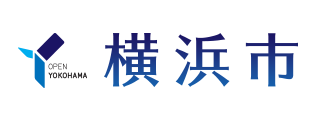Here's the text.
May 2024 issue Noto Peninsula and Yokohama
Yokohama with sea, port, greenery, history, region, people and various attractions. We will deliver the color of this city as "Yokohama Aya Discovery". This time, I would like to talk about the connection between Noto (Ishikawa Prefecture), which was severely damaged by the January earthquake, and Yokohama.
Last Updated June 3, 2024
As for the publication contents of "public information Yokohama" May, 2024 issue "Yokohama Aya discovery", please see link.
Noto Peninsula and Yokohama
Ritsuto Yoshida, Chief Researcher, Museum of Yokohama Urban History
On the New Year's Day of 2024 (Reiwa 6), a magnitude 7.6 earthquake with the epicenter at the tip of the Noto Peninsula occurred, and the Hokuriku region was hit by a large shaking, with seismic intensity 7 recorded in Shika Town and Wajima City. . Many people are still living in a difficult life in affected areas, such as tsunami, landslides and large-scale fires, and it takes time to restore roads and waterworks.
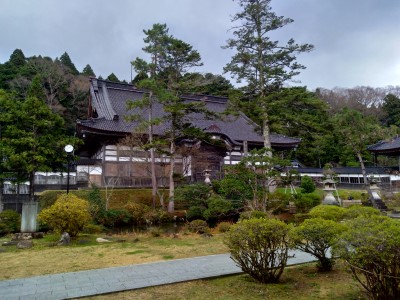
Shooted on December 4, 2022, Omotoyama Sojiin and Daisodo in Monzen-cho, Wajima City
The Noto Peninsula from Yokohama is far away, but it has a deep connection. For example, So Temple of the Soto sect in Tsurumi Ward originated in Mon, Wajima City. In addition, many of the roots of the people who run and support public baths in Yokohama City were located on the Noto Peninsula. At shrines in Kashima-gun, Hakui-gun, and Nanao-shi in Ishikawa Prefecture, the letters "Yokohama" are engraved on torii, komainu, and lanterns. The successful public bath manager in Yokohama actively donated money as a return to his hometown, and there was a flow in which people who saw it moved to Yokohama more. The public health of Yokohama citizens was supported by people from Noto Peninsula.
Since the opening of the port in 1859 (Ansei 6), the land of Yokohama has built a community by accepting immigrants from various regions, both in Japan and overseas. Through migrants to cities, like the Noto Peninsula, Yokohama is connected to various regions.
Here, we introduce the connection between Noto Peninsula and Yokohama, along with photographs of the city of Yokohama and the Noto Peninsula, focusing on the contents of the special exhibition "Sento and Yokohama" held at the Yokohama Museum of History in Yokohama Archives of History in 2018.
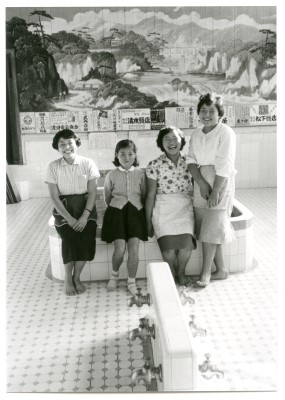
Employees of Nakanoyu, Nishi Ward Fujidana, September 28, 1958, taken by the parent of Hirose, Yokohama Archives of History
The bathroom of Nakanoyu in Fujidana housing complex, Nishi Ward. A photograph of a female employee before the start of business. The smile is impressive with the light of the soft day. The owner of Nakanoyu is from the Noto Peninsula, and employees came from the Noto Peninsula. The work of female employees ranged from customer service to baby care and cleaning. You can see karan (water tap) in front of the women, and paint pictures and advertisements on the back wall. You can see the bathrooms and facilities in the 1930s.
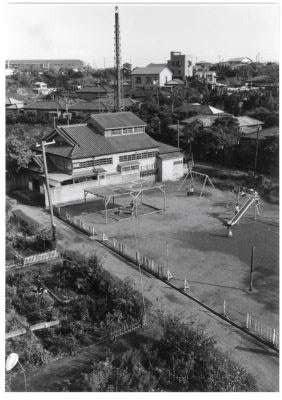
A panoramic view of Nakanoyu, Nishi Ward Fujidana, Yokohama Archives of History, taken by the parent of Hirose on September 28, 1958
Nakanoyu, which is adjacent to the prefectural Fujidana housing complex and the park, was a place for residents to relax. Although the number of public baths in Yokohama dropped sharply due to the war in World War II, the number of public baths in Yokohama increased due to high economic growth, and in the 1940s and 1940s, it stabilized at around 340s. This photo was taken during such a heyday after the war. Hiroshi Hirose, the photographer, from Kofu City, Yamanashi Prefecture, is a resident of the housing complex prefectural Fujidana, who regularly interacted with people from Nakanoyu.
Statue of Ejiri Fukumatsu, September 12, 2019
This bust is located on the grounds of Renjoji Temple in Nakajima, Nanao City, Ishikawa Prefecture. It was erected on May 20, 1972 by the "Nakajimacho Ejiri Fukumatsu Honoring Society". Fukumatsu, born in Nakajima on January 1, 1899 (Meiji 32), moved to Tokyo in 1913 (Daisho 2) and trained at a public bath, and became independent as a manager in 1923 (Daisho 12). After that, he managed several public baths, mainly in Asahiyu, Tsurucommunity hall, and donated large amounts to shrines and temples.
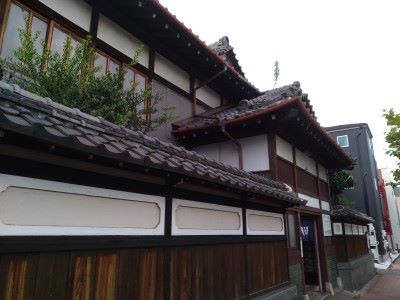
August 6, 2021, "Asahiyu," Tsurumi-ku barley run by Ejiri Fukumatsu
People from Noto Peninsula have expanded their business to other industries based on public baths. Fukumatsu also sold bath salts and also managed the transportation industry. After the war, Fukumatsu became a leading figure in the industry, including serving as the first president of the Kanagawa Prefectural Public Bath Environmental Sanitation Association. Many young people came from their hometown to admire Fukumatsu, but the trend has ceased with the end of high economic growth. Due to the mechanization of equipment, public baths were mainly family management.
Stone pillars of Hito Maro and Mishima Shrine Photographed on November 14, 2017
Hito and Mishima Shrine are located in Seara, Nakajima-cho, Nanao-shi, Ishikawa Prefecture. The company's stone pillar was erected on March 11, 1942 (Showa 17) by Otoyoshi Takenaka, who ran "Fuji Takeyu" in Tennoucho, Hodogaya-ku, and the word "Yokohama" is engraved. I have. With Takenaka's success, you can see his thoughts on his hometown. Ishidorii was donated in August 1987 (Showa 62) by Seiichiro Maruyama, who ran "" in Ginza, Tokyo. Unfortunately, both the stone pillars and Ishidorii were broken by the Noto Peninsula Earthquake.
Ishidorii of Hisashi Hiko Shrine Photo taken on November 15, 2017
Shrine is located in Ku, Nakanoto-cho Kashima-gun, Ishikawa Prefecture. Ishidorii was established in September 1922 (Daisho 11) by the Tokyo Yokohama Rakushinkai, organized by people from Hisae. Tomio Tomiyama (Fujimi-cho, Naka-ku, `` Koshinoyu ''), who served as chairman of the Kanagawa Bath Association and the Yokohama Bathhouse Association in the early Showa War as a public bath manager in Yokohama, and Kuyoshi Kado (Naka-ku Makita-cho "Eikuyu"), Utaro Nakamura (Isesagi-cho, Naka-ku) and Utaro Ishida (Nishibe-cho, Naka-ku) (Nishizawa, Naka-ku) can be confirmed).
Ishidorii of Notohi Shrine Photo taken on September 11, 2019
tohime Shrine is located in Noto subordinate, Nakano-cho, Kashima-gun, Ishikawa Prefecture. Ishidorii was donated in 1923 (Daisho 12) by Keitaro Nagase, a glass wholesaler. The industry magazine "Bath Bath Review" published in January 1935 (Showa 10) describes Keitaro as "a huge number of wealthy people." Keitaro is the brother-in-law of Tomio Tomiyama, and handles glassware used by public baths in Yokohama, such as mirrors, cups and glassware. People from the Noto Peninsula also took root in public baths and related industries.
Name of donor engraved on pillar September 11, 2019
The Ishidorii of Notohime Shrine is engraved with "Keitaro Nagase, 1-51, Fukutomi-cho, Yokohama-shi". In the public bath industry in Yokohama, there was a network of people from Noto Peninsula. For example, in the same Fukudomimachi, there is "Fukutomiyu" owned by Goro Tamata (currently from Sone Nakanoto-cho, Kashima-gun), who served as chairman of the Federation of Yokohama Bathing Association, and its management is Tomio Tomiyama's niece Hikoharu Matsuda (born Hisae), the husband of his niece. Keitaro also supported the activities of Hikoji, a distant relative.
As you can see, you can be impressed by the depth of local love for the Noto Peninsula, the hometown where the successful public bath manager in Yokohama was born and raised. Young people who came out of Noto's mountain villages and fishing villages to Yokohama began to nest as new managers after training at relatives and fellow citizens' public baths. In addition, there were many public bath owners from Niigata and Toyama prefectures in Yokohama, and they built a network of fellow travelers just like Noto. I would like to reflect on the history of such urban immigrants and the connection between Noto and Yokohama, and support and support the reconstruction of Noto from Yokohama.
※For more information, please refer to Museum of Yokohama Urban History Bulletin No.18 (March 2024) and Yokohama Archives of History / Yokohama Museum of History, "Sento and Yokohama" (Yokohama City Hometown History Foundation, 2018).
Notice
In conjunction with the reopening of Museum of Yokohama Urban History on Saturday, July 20, 2024, a panel exhibition "Noto Peninsula and Yokohama: Exchange between People Connected by Public Baths" will be held. The exhibition period is from Saturday, July 20, 2024 to Sunday, September 29. We look forward to your visit.
[Reception end] Reader present
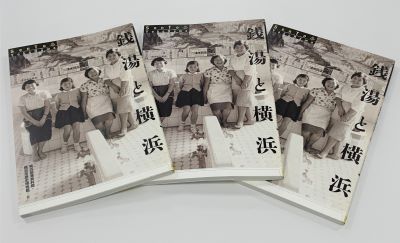
The application has been closed and prizes have been sent to the winners on Monday, June 3rd. Thank you very much for your application.
Thank you for always seeing "Public Information Yokohama" and "Yokohama Aya Discovery". Three people will present the catalog "Sento and Yokohama" of the special exhibition "Sento and Yokohama - People Surrounding Yu" held in Yokohama Archives of History in 2018. If you wish, please refer to the following six items. ※Please specify and apply by postcard (to Yokohama City Hall Policy and Management Bureau, 6-50-10 Honcho, Naka-ku, Yokohama 231-0005) or e-mail (sss-saihakken@city.yokohama.jp). The deadline must arrive on Friday, May 31, 2024.
※ 1.Postal code, 2. Address, 3. Name, 4. Impression, 5. I would like to read, 6. "May issue present hope"
The winner's announcement will be returned by sending the prize. In addition, the personal information you receive will not be used for any purpose other than sending prizes.
Public Relations Section, Policy Management Bureau, Yokohama City Hall TEL: 045‐671-2331 FAX: 045‐661-2351
Inquiries to this page
Public Relations Section, City Promotion Promotion Office, Policy Management Bureau
Telephone: 045-671-2331
Telephone: 045-671-2331
Fax: 045-661-2351
Email address: ss-koho@city.yokohama.lg.jp
Page ID: 502-950-210

